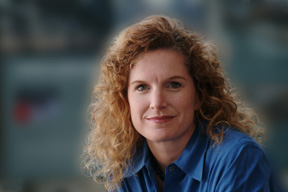Think you got headaches? Meet the new head of the Port of San Francisco

Published: July, 2004
Bay Crossings: It’s no secret that the Port of San Francisco is facing pretty big challenges. How did Mayor Newsom talk you into taking this job?
MONIQUE MOYER: I don’t think I can reveal that. But it took a lot of back and forth with the Mayor; I’ll admit to that.
BC: You’ve had a chance to get your feet on the ground. How’s the Port doing—better or worse than you expected?
MM: That’s an interesting question. The Port is a very complex entity, as is anything related to San Francisco. Aspects have surprised me positively, and one of those is the immense number of disparate people who are totally engaged in the Port. Many are cheering for the Port’s success, maybe not for me personally, but for a vision of what the Port might be. I have not seen that so consistently in other departments of the city where I’ve worked. On the organizational side, I have been disappointed with the lack of coherent policies and procedures. So we’re working hard to fix that.
BC: First came SBC, now the Ferry Building is all the rage and more snazzy projects are coming soon for the central waterfront. What are the implications of this movement for Fisherman’s Wharf?
MM: I don’t think that the implications are negative. The tremendous historic streetcars up and down the waterfront are packed. I think it just means more people are coming to the waterfront, which is our goal.
BW: How does the southern waterfront area, including Hunter’s Point, figure in your plans?
MM: For me personally the southern waterfront is extremely important, particularly the area from Pier 48, which is right across from SBC Park, down to Pier 98. As Mission Bay continues to develop and the Third Street Light Rail gets going, that whole area of town is getting a face-lift. And our piers will need a face lift, as well, since we will soon have 6,000 new people as our neighbors at Mission Bay.
BC: Former San Francisco mayor, now U.S. Senator Dianne Feinstein, has publicly called for regionalizing all the Bay Area’s seaports and airports. Your thoughts?
MM: That would be very interesting. I do think that the Port of San Francisco and the Port of Oakland are good counter-ports, if you will, to each other. We do different things. I think the Port of Oakland has been extremely successful in not trying to be all things to all people, and they have utilized their resources to excel at what their particular topography offers. And I would like to think that the Port of San Francisco is moving in that direction, as well. Would one regional port make sense? Hard to say. You know, as we have found with transportation, that’s not always the panacea that we want it to be.
BC: Short of outright regionalization, should the Ports of Oakland and San Francisco be cooperating wherever possible?
MM: Oh, I absolutely think so, and I’ve already met with the outgoing director, and have offered to meet with the incoming director, Jerry Bridges. We already consult with them at the middle management level, and I would like to see us do more at the senior management level.
BC: The Port of San Francisco is a so-called “enterprise agency,” meaning it must pay its own way. It does so mostly by renting space. Yet the Port’s relationship with its tenants is frayed by infrastructure problems, which will take big sums of money to fix. How do you explain to the voters of San Francisco that they need to make this investment?
MM: Well, I think that you don’t do it in a vacuum. San Francisco is a mature city with a mature infrastructure, i.e., sewers, the water system, roads. And obviously the Port’s infrastructure is no exception. So I think you have to talk about that in context. I don’t think that this particular generation needs to pay for everything that future generations will benefit from. We need to think about that obligation, and that’s why debt makes sense.
Lastly, I think the Port has to raise its credibility. That’s my goal, that’s my first responsibility, before we can begin to seek the generosity of the voters to help with our problems.
BC: Frankly, for generations, the Port has been a glad bag of patronage jobs and politically motivated deal making. How do you change that? Is it realistic to think that anyone can?
MM: I ask myself that question over and over. The Port is expected to be a lot of things to a lot of people yet it in reality it has very little in the way of resources, however you measure them. We manage 18.6 million square feet of facilities and piers, with just 200 people. It’s an amazing feat. We can’t go through life being on the defensive; that just won’t work. It’s my job to make sure that the Commission of the Port and the Board of Supervisors are seeking the same direction, and stop having such fractionalism.
BC: Finally: the Port staff has been through a lot. What can you do to improve morale?
MM: We’re doing it. It was unfortunate but unavoidable that I had to do layoffs right away, but I definitely made sure that the layoffs were not at the lowest level of the organization. People in the organization have been through a lot because they have an intense attachment to the Port. And they are hopeful, with good reason, that there is a new day ahead. I’ve already met with more than half of the employees on a one-to-one basis. Everyone has great ideas and the people of the Port know the Port better than I ever will. Together, we’ll make it work.

